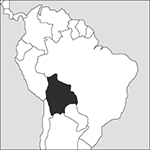
Source: MAPS IN MINUTES™ © RH Publications (1997)
Capital:
La Paz (administrative); Sucre (judicial)
Area:
1,098,581 sq km (424,164 sq miles)
Population:
10,461,053 (2012 est)
Currency:
1 boliviano = 100 centavos
Religions:
Roman Catholic 95.0%; Protestant 5.0%
Ethnic Groups:
Quechua 30.0%; Mestizo 30.0%; Aymara 25.0%; White (mainly Spanish extraction) 15.0%
Languages:
Spanish, Aymara, Quechua, and 34 other indigenous languages (all official)
International Organizations:
UN; OAS; Andean Community; Non-Aligned Movement; WTO
A landlocked country of central South America. It is bounded by Brazil and Paraguay to the north and east, Argentina to the south, and Peru and Chile to the west.
Physical
In the south-west is a great plateau, the Altiplano, some 800 km (500 miles) long and 3,660 m (12,000 feet) high, set between two even loftier ranges of the Andes. At its northern end is the southern shore of a huge mountain lake, Titicaca, while in the south there are vast salt pans. The north-east by contrast has low plains with hot, wet rainforest and several navigable rivers. Southward the ground rises to plains which are covered with woodland and grass.
Economy
The mountains of Bolivia offer large deposits of minerals: mining and smelting are the principal industries. Other industry includes natural gas and oil production, textiles, and food processing. Natural gas and tin, of which Bolivia is one of the world’s largest producers, are major exports. Principal agricultural crops include soya beans, coffee, and coca; the last is processed into cocaine, of which Bolivia is the world’s third largest producer. Bolivia’s economy has suffered from protracted political instability, fluctuating commodity prices, a large external debt, high inflation, and lack of investment.
History
The area became an important Ayamará Indian state between 600 and 1000 ad but was conquered by the growing Inca state c.1200. Some Ayamará continued to resist, however, and were not completely subdued until the late 15th century, Spanish conquest followed six years after Francisco Pizarro’s landing in Peru in 1532, and in 1539 the capital at Charcas (modern Sucre) was founded. The discovery of silver deposits in the Potosí mountains in 1545 led to the establishment of the Audiencia (a high court with a political role) of Charcas, under the viceroyalty of Peru. Revolutionary movements against Spain occurred here earlier than anywhere else in South America—at La Paz in 1661, Cochabamba in 1730, and Charcas, Cochabamba, La Paz, and Oruro in 1776–80—but all failed.
Independence was finally won under José de Sucre, at the battle of Ayacucho (1824). A National Assembly declared Upper Peru independent, and named it Bolivia after Simón Bolívar. A short-lived Peru-Bolivian Confederation was formed (1825–39). Control of the Atacama coast region, where rich guano nitrate deposits were found, was challenged by Chile in 1842 and finally lost in 1884 in the disastrous War of the Pacific. A series of military dictatorships (1839–80) was succeeded by more liberal regimes, with Liberal and Republican Parties alternating. In 1930 a popular revolution elected a reforming President, Daniel Salamanca. In 1936, following the disastrous Chaco War, military rule returned. In 1952 the Bolivian National Revolution overthrew the dictatorship of the junta, and Paz Estenssoro, leader of the MNR (Movimento Nacionalista Revolucionario) Party returned from exile and was installed as President. Tin mines were nationalized, adult suffrage introduced, and a bold programme of social reforms begun. Paz was re-elected in 1960 but overthrown in 1964 by a military coup. In 1967 a communist revolutionary movement, led by Ché Guevara, was defeated. Military regimes followed each other quickly. Not all were right-wing, and that of General Juan José Torres (1970–71) sought to replace Congress by workers’ soviets. Democratic elections were restored in 1978, but there was another military coup in 1980 and a state of political tension continued until 1982, when civilian rule was restored. A succession of Presidents—including the return of Paz Estenssoro (1985–89) and a former military dictator, Hugo Banzer (1997–2001)—struggled with economic problems and the unrest caused by attempts to resolve them. Free-market reforms led to economic growth in the 1990s and vigorous action was taken against the cultivation of coca. However, progress stalled thereafter: economic growth slowed from 1999, and coca production increased in the early 21st century. In 2006 Juan Evo Morales became Bolivia’s first indigenous President. His programme of nationalization and wealth redistribution caused political divisions and unrest; but it was popular with the poor indigenous majority and Morales was re-elected in 2009 and again in 2014. However, in 2016, he just lost a referendum on changing the constitution to allow him to stand for president again in the 2020 elections, a sign of his decreasing appeal. Then in December 2017, the Bolivian courts overruled the constitution to remove all term limits, allowing Morales to stand again for a fourth term.
In 2015 the International Court of Justice decided that it can adjudicate in Bolivia’s long-standing claim to a stretch of Chilean coast which it lost in 1884 in the War of the Pacific, a claim dismissed by Chile.
- Lucas theorem
- lucida
- Lucid, Shannon Matilda Wells (1943– )
- luciferase
- luciferin
- lucinoid
- Lucknow, Siege of (1857–58)
- Lucretius (99/94–55/51)
- Luddite
- Topa Inca
- topaz
- top carnivore
- top-down development
- top-down hierarchical design
- top-down nanofabrication
- top-down parsing
- tope
- TOPEX/Poseidon
- topic drift
- topic-neutral
- toplap
- top-level domain
- topocentric
- topocentric coordinates
- top of atmosphere